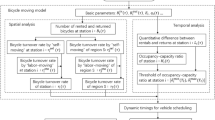Abstract
Airport bus is an important public transportation mode for large international airport. To improve the bus station coverage, passenger demand compatibility and the scheduling flexibility of Beijing International Airport bus line, a dynamic line generation and vehicle scheduling method is proposed in this paper. Firstly, based on multi-source big data from the airport (including data from taxi, ride-hailing service, subway, regular bus, airport bus, etc.), we accurately extract candidate stations, which are very popular with passengers and convenient for parking and transfer, through public transportation demand level calculation, iterative clustering and POI matching. Then, the candidate stations need to be partitioned appropriately by selecting suitable features and calculating the similarity of candidate stations, so as to make the stations within each group a moderate size and have a consistent spatial orientation. Finally, a line generation and vehicle scheduling algorithm, which is compatible with multi-vehicle, high success rate of ride-sharing matching and low cost, is designed to realize accurate and rapid operation scheduling within each group according to the situation of passengers booking tickets. We have carried out experiments in Wangjing and Yayuncun, and the results show that our method can satisfy passenger demand fast and accurately.

















Similar content being viewed by others
References
China Road Transport (2016) The 13th five-year plan for urban public transportation. 9:24–29
Beijing Public Transport Corporation and Beijing Bus (2016) The 2016 social responsibility report. 6:40–41
Dessouky M, Hall R, Nowroozi A (1994) Bus dispatching at timed transfer transit stations using bus tracking technology. Transp Res Part C Emerg Technol 7(4):187–208
Cayford R, Yim Y (2004) Personalized demand-responsive transit service. UCB-PRR-2004-12, California PATH, Berkeley
Horn MET (2004) Procedures for planning multi-leg journeys with fixed-route and demand-responsive passenger transport services. Transp Res Part C Emerg Technol 12(1):33–55
Horn MET (2002) Multi-modal and demand-responsive passenger transport systems: a modelling framework with embedded control systems. Transp Res Part A 36(2):167–188
Agatz N, Erera A, Savelsbergh MWP (2011) Dynamic ride-sharing: a simulation study in metro Atlanta. Transp Res Part B Methodol 45(9):1450–1464
Zeitler E, Risch T (2011) Massive scale-out of expensive continuous queries. Proc Vldb Endow 4(11):1181–1188
Fud A (2000) FDBSCAN: a fast DBSCAN algorithm. J Softw 11(6):32–34
Duckham M, Kulik L, Worboys M (2008) Efficient generation of simple polygons for characterizing the shape of a set of points in the plane. Pattern Recognit 41(10):3224–3236
Shang FH, Jiao LC, Shi JR (2012) Fast affinity propagation clustering: a multilevel approach. Pattern Recognit. 45:474–486
Zhang Z, Wang BQ, Li XT (2013) Semi-supervised traffic identification based on affinity propagation. ACTA 39(7):1100–1109
Xiao Y, Yu J (2008) Semi-Supervised clustering based on affinity propagation algorithm. J Softw 19(11):2803–2813
Taillard E, Badeau P, Gendreau M (1997) A tabu search heuristic for the vehicle routing problem with soft time windows. Transp Sci 31(3):469–477
Baker BM, Ayechew MA (2003) A genetic algorithm for the vehicle routing problem. Comput Oper Res 30(5):787–800
Prins C (2004) A simple and effective evolutionary algorithm for the vehicle routing problem. Comput Oper Res 31(12):1985–2002
Pardalos PM, Rodgers GP (1990) Computational aspects of a branch and bound algorithm for quadratic zero-one programming. Computing 45(2):131–144
D’Ariano A, Pacciarelli D, Pranzo M (2007) A branch and bound algorithm for scheduling trains in a railway network. Eur J Oper Res 183(2):643–657
Acknowledgements
This work was partly supported by Science and Technology Plan Project of Beijing (No. Z171100005117001), partly by the Program of Beijing Outstanding Talent Training Foundation (No. 2017000021063G008) and partly by Grants from the National Engineering Laboratory for Comprehensive Transportation Big Data Application Technology.
Author information
Authors and Affiliations
Corresponding author
Ethics declarations
Conflict of interest
All authors declare that they have no conflict of interest in this research.
Human and animal rights
This article does not contain any studies with human participants or animals performed by any of the authors.
Informed consent
Informed consent was obtained from all individual participants included in the study.
Additional information
Communicated by X. Li.
Publisher's Note
Springer Nature remains neutral with regard to jurisdictional claims in published maps and institutional affiliations.
Rights and permissions
About this article
Cite this article
Yu, H., Lv, W., Liu, H. et al. A dynamic line generation and vehicle scheduling method for airport bus line based on multi-source big travel data. Soft Comput 24, 6329–6344 (2020). https://doi.org/10.1007/s00500-019-03987-4
Published:
Issue Date:
DOI: https://doi.org/10.1007/s00500-019-03987-4




